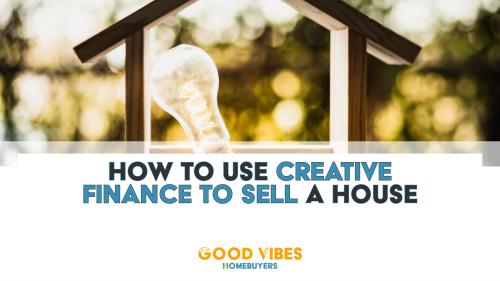
If you visit other real estate investor and iBuyer websites, you’re going to find that nearly all of them pitch one and only one way to sell your house: for cash. There is nothing wrong with this method – even we regularly provide homeowners with all-cash offers, however, they will likely net sellers the least money and if we’ve learned anything in this business, it’s that sellers want to sell for the most money possible.
Since the marketplace lacks options for sellers to achieve that, Good Vibes Homebuyers (GVH) saw an opportunity to fill the void by providing sellers with other choices that allow them to sell for the most money possible and still enjoy the convenience, benefits, and certainty of a cash-only transaction. This article explains what creative financing is when selling real estate, the 5 types of creative financing techniques, and how to use creative financing to sell your house or apartment.
What’s in it for you
Creative financing to sell real estate refers to unique funding arrangements an individual can use to sell their property. In short, methods of financing the sale of real estate are considered “creative” when it does not involve a conventional mortgage loan. Some examples of unique ways to sell real estate are lease-options, seller finance, mortgage assumption, wrap-around mortgage, and any combination of these special real estate financing arrangements.
Creative finance in property sales has been around for as long as people have been buying and selling real property, but it went mainstream during the late ‘70s and early ‘80s. With hyperinflated interest rates as elevated as 18%, buyers and sellers conceived of all kinds of creative agreements to finance real estate without the need for traditional loans. Without it then, the real estate market would have ground to a halt, and as inflation hits 50-year highs today, innovative financing arrangements are primed to be even more prevalent as sellers try to sell for the most money possible and buyers try to buy with as little cash out of pocket as possible.
To best understand your options, you must first see how using creative finance to sell your house differs from the conventional finance process. In traditional transactions, 6 parties are typically involved: the seller, the seller’s realtor, the buyer, the buyer’s realtor, the bank, and the title company. Before closing, the seller’s realtor and the buyer’s realtor would negotiate an agreement, the seller and buyer would sign the purchase and sale agreement, and the buyer would then apply for a mortgage with a bank to finance the agreed-upon price. The purchase and sale agreement would then be sent to the title company for clearing and closing the transaction. Assuming the bank approves the buyer for a mortgage, and assuming the bank doesn’t require the seller to make extensive and expensive repairs, the bank wires money to the title company who then wires money to the seller in exchange for the property’s deed.
According to the Federal Reserve Economic Research Center, the time to complete the traditional finance process averages 87 days. Compare that to the creative finance process, and 3 of the 6 parties are eliminated: the seller’s realtor, the buyer’s realtor, and the bank. In so doing, the time for sellers to sell property using creative finance averages just 7 days with GVH, and the cost of paying closing fees and 2 realtor commissions is eliminated.
As the idiom goes, there’s more than one way to skin a cat, and depending on your financial situation or equity in your home, using creative finance to sell may make the most sense and will net you the most money. Consider these 5 simple ways to sell a home with creative finance:
A lease option in real estate is commonly known as “rent to own” and is GVHs “rent now, sell my house later” service. In short, a lease-option is a creative financing arrangement that allows a seller to rent the home to a tenant for a specified period, usually five years or fewer, with the tenant having the option, but not the obligation, to buy the house at the end of the lease at the price agreed upon when the lease was signed. In typical lease option agreements, sellers receive an initial down payment, and a percentage of the monthly rent is credited toward the buyer’s purchase price. If the tenant/buyer opts not to purchase the house, the seller keeps both the down payment and all rent credits.
Owner financing the sale of a property is great for sellers who don’t mind foregoing a little cash today in exchange for streams of passive income tomorrow. In this method of real estate creative financing, which is GVHs “the way to sell a home for more” service, the seller takes on the role of the lender but instead of giving cash to the buyer like a bank would, the seller simply extends credit in the amount of the agreed upon sale price minus the buyer’s down payment. With this creative real estate sales financing technique, the terms of the loan can be customized to suit both seller and buyer. For instance, the sale price, the down payment, the monthly payment, and the length of the loan are all customizable. In typical seller finance scenarios, sellers receive an initial down payment, monthly payments, and a large lump sum payment for the remaining balance of the loan, called a “balloon payment”, at the end of the loan’s term. Learn more about this method of creative ways to finance the sale of real estate in this top-rated Google article.
A mortgage assumption is a creative property sales technique that is commonly known as “subject-to” and is GVHs “sell a home’s mortgage” service. In short, mortgage assumption finance for the sale of property is when a buyer takes over the mortgage payments and all other financial obligations of the property, but the existing mortgage remains in the seller’s name. In return, sellers receive a one-time lump sum payment for 100% of their home’s equity, all late mortgage payments are brought current, and sellers typically do not pay closing costs, which can be upward of 15%. Learn more about this creative finance technique to sell real estate in this page one Google article.
A wrap around mortgage is a unique way to sell real property and is commonly known as a “wrap loan”. In this real estate creative financing technique, the seller in a wraparound transaction keeps the property’s existing loan in place while providing a new loan to the buyer that “wraps around” the existing loan. The amount of the wrap loan provided by the seller is the difference between the existing mortgage balance and the sale price, minus the buyer’s down payment. As a unique approach to financing the sale of houses and apartments, wrap around mortgage arrangements commonly include an “interest spread” which is the difference pocketed by the seller between the interest rate of the exiting loan and the interest rate of the wrap loan. Just as important, the buyer pays interest at the agreed upon interest rate on the full amount of both loans, not just interest on the amount of the wrap loan.
In every real estate sale, there are ways to use creative finance to net sellers more, and often homeowners can combine two of these unique property sale arrangements. For instance, when we buy houses through the mortgage assumption creative finance method, a seller finance component could be included if a homeowner has more than 25% equity. In so doing, sellers receive monthly payments, in addition to a one-time lump sum payment. Similarly, a wrap-around mortgage is in essence a creative owner finance and mortgage assumption transaction for selling houses since the mortgage stays in place and the seller issues a new loan.
Instead of trying to explain the process to creatively finance the sale of a house, we find it best to play out each creative funding scenario. Below are recent real-life examples of how unique financing transactions have worked with Good Vibes Homebuyers.
Seller Sammy has been thinking about selling his property but he’s not sure the current real estate market will bear the $200,000 price he wants. He decides not to sell today and instead to use lease option creative financing to sell tomorrow. Seller Sammy finds a tenant named Buyer Bill who will lease the home for 3 years provided he has the option to buy the home at the end of his lease. Seller Sammy and Buyer Bill agree to the following: Buyer Bill may buy the home in 3 years for $200,000, but for that right, Buyer Bill must pay a deposit of $10,000, and if he exercises his option to buy the home, the $10,000 deposit will be credited toward the $200,000 sale price. If he doesn’t exercise his option to buy, Seller Sammy keeps the $10,000.
Meanwhile, Seller Sammy’s mortgage payment is $644.19, and Buyer Bill pays $1,400 a month in rent, of which, $400 is credited toward the $200,000 sale price if Buyer Bill exercises his option to buy (if he doesn’t, Seller Sammy keeps all monthly credits). In reality, Seller Sammy has used the creative finance lease option technique to either sell his home for his asking price of $200,000 plus an extra $12,809 due to the spread between his mortgage payment and the monthly rent minus the rent credit, or he keeps the home and has gained $37,209 ($10,000 down payment + $27,209 spread between his mortgage payment and monthly rent).
Seller Sammy wants to sell his home for $200,000 but based on recent comparable sales, the home is justifiably worth just $180,000. Buyer Bill wants to buy the home and is even willing to pay $200,000, provided Seller Sammy creatively finances the home via seller finance. Seller Sammy and Buyer Bill agree to the following: Seller Sammy gets his $200,000 asking price, a $20,000 (10%) down payment, and monthly payments of $375 for 5 years (60 months). Buyer Bill now owns the house and in 5 years he must pay Seller Sammy the remaining balance of $157,500 in one lump sum. If Buyer Bill fails to make the monthly payments or if he’s unable to pay off the creative seller financed balance by month 60, Seller Sammy gets to keep the down payment, all monthly payments, and he takes back ownership of the home which, over the course of 5 years, has likely gone up significantly in value (example: it would be worth $267,600 at 6% annual appreciation).
Seller Sammy wants to sell his home for $200,000, which is in line with recent comparable sales. However, Seller Sammy bought his house 18 months ago and he put down just 5% ($10,000) so his mortgage balance today is $185,740. With the cost to sell a home on the open market ranging from 10% to 15%, Seller Sammy realizes that he’s not going to make any money, and, in fact, he’s going to have to pay between $5,000 and $15,000 to sell his home. That sounds terrible, so Seller Sammy contacts Buyer Bill at Good Vibes Homebuyers to discuss creative financing techniques to use for selling his home. Buyer Bill explains that he will buy Seller Sammy’s home for $200,000 provided he sell via mortgage assumption, an out-of-the-box method for financing real estate sales.
Seller Sammy and Buyer Bill agree to the following: Seller Sammy gets his $200,000 asking price, he pays zero closing costs, he receives a one-time lump sum payment for his equity ($14,260), and he keeps the existing mortgage in-place. In exchange, Buyer Bill now owns the home and pays all financial obligations associated with it, including the monthly mortgage payment.
Seller Sammy wants to sell his home for $200,000 and Buyer Bill wants to buy the home at that price and will even put down 10% ($20,000), provided Seller Sammy extends him credit for $180,000. Seller Sammy doesn’t have enough cash to pay off his existing mortgage which has a 5% interest rate and a balance of $120,000, so Seller Sammy agrees to sell his home creatively by using a wrap-around mortgage whereby he extends Buyer Bill $180,000 in credit at 8% interest.
In so doing, Buyer Bill pays Seller Sammy a monthly principal and interest payment of $1,320.78 on his 8%, $180,000 wrap mortgage. Seller Sammy’s existing mortgage payment is just $644.19 so Seller Sammy pockets a spread of $676.59 every month. Even better, since Seller Sammy really extended just $60,000 in credit by using the creative finance wrap around mortgage technique, his effective interest rate is actually earning him a 13.53% return ($676.59 x 12 months) = ($8,119.08) / ($60,000).
Why would a homeowner not use a realtor or not try selling FSBO on the open market? Not only will this section answer these questions, but it’ll give you 4 big reasons why many Texans avoid the traditional sale process altogether and instead opt for selling a home that’s creatively financed. To set the stage, consider the time it takes to find a quality realtor, to endure home showings, to navigate through buyer bank approvals, to hopefully, ultimately, close on the sale of your house (fingers-crossed). The traditional sales process is extensive, arduous, uncertain, and costly, which leads us to the number 1 reason why sellers sell homes with creative finance.
With absolute certainty, using creative finance results in more money in a seller’s pocket than any other way of selling. How? 2 reasons. First, but least important, sellers avoid the 10-15% fees it takes to sell on the open market. For example, selling a $200,000 house through traditional means is really like selling for $180,000 to $170,000. Second, selling through creative finance methods allows sellers to negotiate terms that result in them getting the price they want and the cash they need when they need it. Which leads us to the second reason to use creative finance to help sellers.
Every seller has a pain point in need of a solution, but the problem is that until after having contacted us, many sellers are unaware a solution even exists. Whatever your pain point, GVHs creative real estate financing services are specifically designed to make it disappear. For instance, we recently worked with a daughter whose parents had just bought a home and two months later, were killed in a car accident. Without even considering the grief of losing her parents, she had no means to pay the mortgage and all the other expenses of home ownership. Another seller was trying to buy a new home but couldn’t until he sold his old house which had lingered on the open market for 7 months. For the first seller, one of our past clients provided a testimonial about how using our “sell a home’s mortgage” service helped her sell with low equity. For the second seller, he was able to get his asking price through our seller finance service plus take advantage of our move later solution. In the end, through thinking creatively about the finance of their home sale, both received the cash they needed, when they needed it, and their pain was resolved in a painless way. Which leads us to the third reason.
In most creative finance deal structures, sellers get paid 3 times: down payment, monthly payments, and one, large lump sum payment at a mutually agreed upon future date. And remember the second reason? Pain! Some pain points are resolved by simply getting rid of a property while others are solved by an immediate infusion of cash. For our seller who had just lost her parents, the money helped her with funeral costs, and we caught her up on past due mortgage payments. For our seller who couldn’t buy his new home before selling his old one, the cash helped with moving costs and the deal’s imaginative structure leads us to the fourth reason why sellers sell a home using creative finance.
Did you know that some unique financing arrangements in real estate sales are considered installment sales by the IRS? An installment sale allows homeowners to spread gains out over several years (as opposed to being taxed on all gains in the first year) which often allows sellers to remain within a lower tax bracket. Additionally, with our seller finance service, for instance, GVH pays sellers interest in the form of a higher sale price. This results in the payments a seller receives being taxed at the capital gains tax rate instead of your personal income tax rate. Capital gains tax ranges from 0% to 20% while personal income tax rates can be as high as 37%. If the house was a seller’s homestead, then they probably won’t have to pay any taxes because they qualify for the IRS homestead tax exemption. As an added bonus, sellers avoid the arduous tax reporting obligations that would be required of interest income.
1. Are there other unique finance methods for selling property?
Yes, a master lease agreement is another method although it’s not common in residential real estate sales.
2. Is creative real estate financing sales common?
According to the National Association of Realtors, 5.64 million homes were sold in 2020 and 733,200 were sold outside the traditional process. As such, 1 out of 10 sales occurred without the involvement of a conventional mortgage loan. For GVH, buying properties through creative real estate finance represents approximately 85% of our transactions.
3. Where can I find more information on using creative finance methods?
Even if you’re outside our service area or aren’t interested in receiving offers from us, we’d still love to offer our expertise and answer any questions for free about the process of selling through alternative home finance methods. Follow us and send us a message on social media or call us direct (ask for Phil or Will).
The right way to finance the sale of a house or an apartment is not limited to the traditional process, you have many creative finance options that stand to benefit your bottom line. GVH gives individuals and other investors ideal alternative methods to sell real estate for more and we customize offers to suit a seller’s unique needs. So, if you’re considering creative finance to sell a property or if the simplicity, advantages, and reliability of selling to honest central Texas investors is attractive, don’t wait, contact Phil and Will at Good Vibes Homebuyers now!
You might also like
Free closing costs. Free Local Move. Zero fees. Sell in 5 days. Sell and stay for 180 days. No equity? Still get $10,000 cash!

Picking the wrong investor can leave you scrambling & empty-handed. Learn how to spot the bad from good investors & see the top reasons to pick Good Vibes Homebuyers.

What sounds better - winning or losing? Home investors don't want you to know these 4 magic negotiation tactics because you'll kick their butt and come out a winner!

Good Vibes Homebuyers might be the perfect option for many Texas property owners needing to sell a house. Ask yourself these questions to see if our investors are right for you.